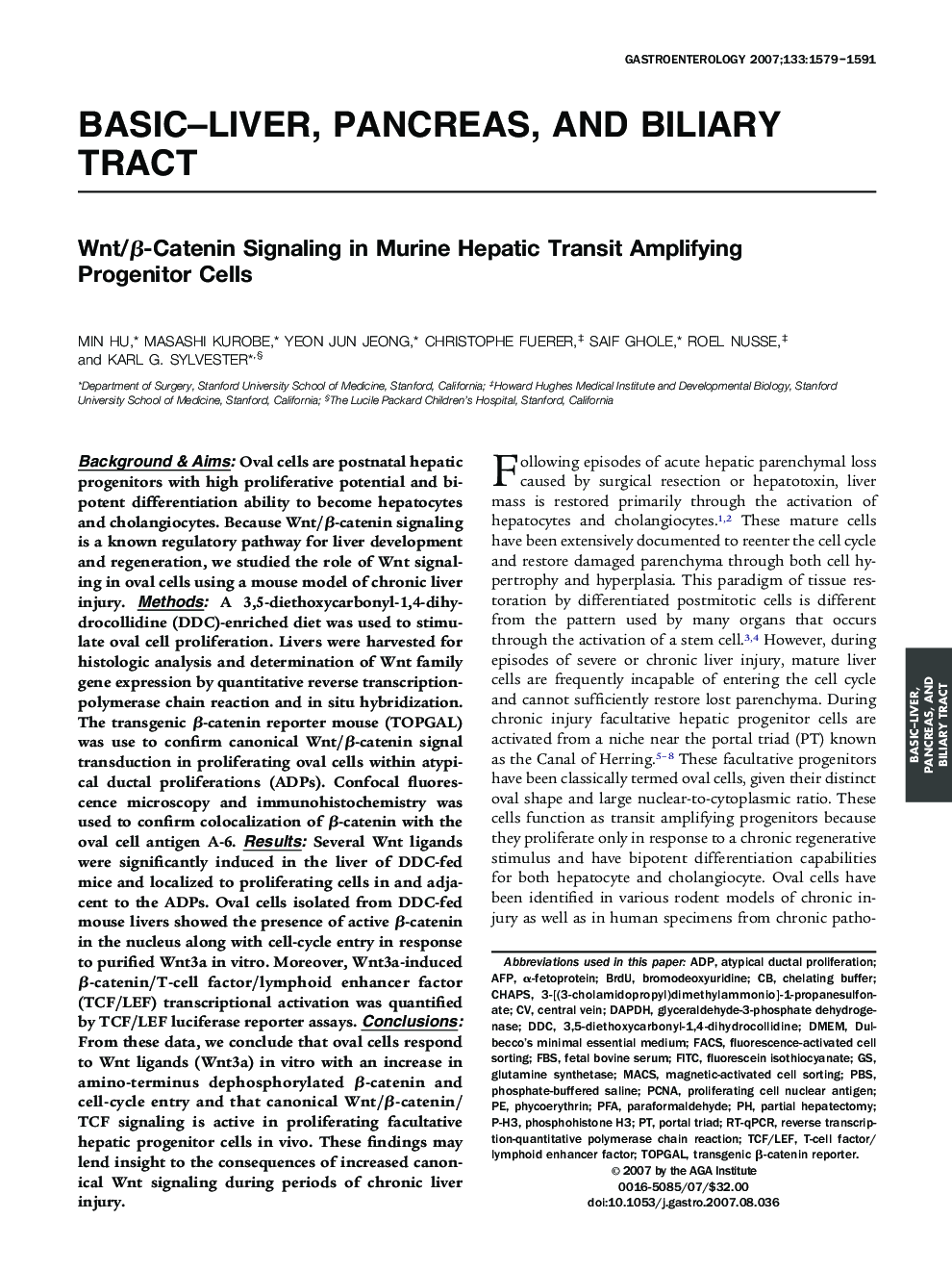| Article ID | Journal | Published Year | Pages | File Type |
|---|---|---|---|---|
| 3296008 | Gastroenterology | 2007 | 14 Pages |
Abstract
Background & Aims: Oval cells are postnatal hepatic progenitors with high proliferative potential and bipotent differentiation ability to become hepatocytes and cholangiocytes. Because Wnt/β-catenin signaling is a known regulatory pathway for liver development and regeneration, we studied the role of Wnt signaling in oval cells using a mouse model of chronic liver injury. Methods: A 3,5-diethoxycarbonyl-1,4-dihydrocollidine (DDC)-enriched diet was used to stimulate oval cell proliferation. Livers were harvested for histologic analysis and determination of Wnt family gene expression by quantitative reverse transcription-polymerase chain reaction and in situ hybridization. The transgenic β-catenin reporter mouse (TOPGAL) was use to confirm canonical Wnt/β-catenin signal transduction in proliferating oval cells within atypical ductal proliferations (ADPs). Confocal fluorescence microscopy and immunohistochemistry was used to confirm colocalization of β-catenin with the oval cell antigen A-6. Results: Several Wnt ligands were significantly induced in the liver of DDC-fed mice and localized to proliferating cells in and adjacent to the ADPs. Oval cells isolated from DDC-fed mouse livers showed the presence of active β-catenin in the nucleus along with cell-cycle entry in response to purified Wnt3a in vitro. Moreover, Wnt3a-induced β-catenin/T-cell factor/lymphoid enhancer factor (TCF/LEF) transcriptional activation was quantified by TCF/LEF luciferase reporter assays. Conclusions: From these data, we conclude that oval cells respond to Wnt ligands (Wnt3a) in vitro with an increase in amino-terminus dephosphorylated β-catenin and cell-cycle entry and that canonical Wnt/β-catenin/TCF signaling is active in proliferating facultative hepatic progenitor cells in vivo. These findings may lend insight to the consequences of increased canonical Wnt signaling during periods of chronic liver injury.
Keywords
PBSPCNADAPDHT-cell factor/lymphoid enhancer factorphosphohistone H3MACSADPPFART-qPCRFACSFITCFBSDMEM3-[(3-cholamidopropyl)dimethylammonio]-1-propanesulfonate3,5-diethoxycarbonyl-1,4-dihydrocollidineddCTCF/LEFα-fetoproteinProliferating Cell Nuclear AntigenBrdUbromodeoxyuridineAFPDulbecco’s Minimal Essential Mediumfluorescence-activated cell sortingcentral veinfetal bovine serumphycoerythrinfluorescein isothiocyanatePhosphate-buffered salinemagnetic-activated cell sortingPartial hepatectomyReverse Transcription-quantitative Polymerase Chain ReactionparaformaldehydeCHAPSGlutamine synthetaseglyceraldehyde-3-phosphate dehydrogenase
Related Topics
Health Sciences
Medicine and Dentistry
Gastroenterology
Authors
Min Hu, Masashi Kurobe, Yeon Jun Jeong, Christophe Fuerer, Saif Ghole, Roel Nusse, Karl G. Sylvester,
